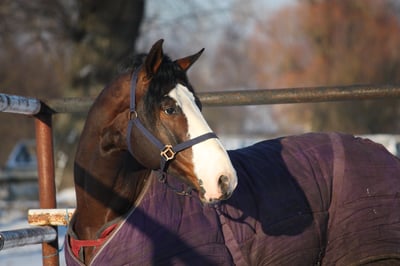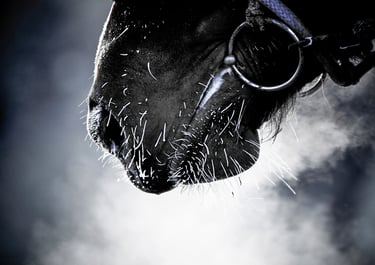Floyd Fain
January 17, 2017 To blanket or not to blanket? Once the mercury dips and the snow falls, it’s only natural for us humans to want to “bundle up” our horses when we winterize our barns. But sheets and blankets are not always necessary or even beneficial.
To blanket or not to blanket? Once the mercury dips and the snow falls, it’s only natural for us humans to want to “bundle up” our horses when we winterize our barns. But sheets and blankets are not always necessary or even beneficial.
Shivery Weather? Not To Dobbin
Unlike us, horses have built-in warming tools. The first, and most obvious is the thick winter coat, which starts growing in late summer and reaches its peak right around the first day of winter. The layers of hair trap warmth and as the temperatures dip, you may notice your horse “puffing” his coat. This fluffing action allows your horses to trap more air closer to their bodies, insulating them from the cold.
Good hay, and plenty of it, stokes the equine furnace, as digestion creates heat from within. And it goes without saying that plentiful water -- heated to a point where horses will want to drink -- helps ward off colic.
Two considerations to take into account as you decide:
1. What Are Your Horse’s Accommodations?
Almost always stalled. A horse who spends most of her days and nights in a draft-free barn is less likely to need an outdoor turnout sheet. However, lack of exercise could cause the shivers, so a light barn blanket can be the answer.
24/7 turnout. Even in rougher weather, a horse acclimated to the outdoors (operative word: acclimated) doesn’t need a sheet to keep warm – but he definitely needs a windbreak, such as a run-in shed or a grove of trees, to protect him from precipitation.
Pay attention to the weather, when a horse’s coat is wet, it decreases their ability to fluff their coat and insulate themselves. A waterproof may be a good investment for horses who do not regularly use shelter.
Turnout by day, stall by night. For a mild winter, a light or medium turnout sheet could be the answer for the in-and-out horse, particularly if the paddock or pasture is not equipped with a wind break. The challenge is to find a blanketing routine that keeps the horse warm outside but won't overheat her once she’s inside.
2. What Shape Is Your Horse In?
Older? Seniors, especially those who tend to drop weight in winter, could benefit from a turnout sheet.
Pregnant? During winter, most mares are in their second or third trimester; hormones are acting up, weight is fluctuating. Ask your vet about blanketing pregnant mares, paying particular attention to the risk of overheating.
Clipped? Horses that get clipped in winter, or have not grown a sufficiently thick coat, should get a turnout sheet in medium or heavy weights aligned to his needs. Particularly for horses that work into a sweat during a cold winter, consider a quarter sheet during warm-up and cool-down, and use a moisture-absorbing wool sweat sheet immediately after his work.
 Keep Tabs
Keep Tabs
No matter what your blanketing preference, it’s vital to keep tabs on the condition of the horse and the sheet all winter long.
Slip your hand under the blanket at the chest area to check for body warmth; check the sheet’s interior for rips that could cause rubs, or dirt and ice trapped underneath.
And Keep A Spare...
Horses are talented at ruining their turnout sheets and blankets, so have a spare on hand for those last-minute switch-outs.
Want To Talk To The Experts?
Contact the folks at Red Master Harrow, and shop our online store for the top arena drags and equipment.

